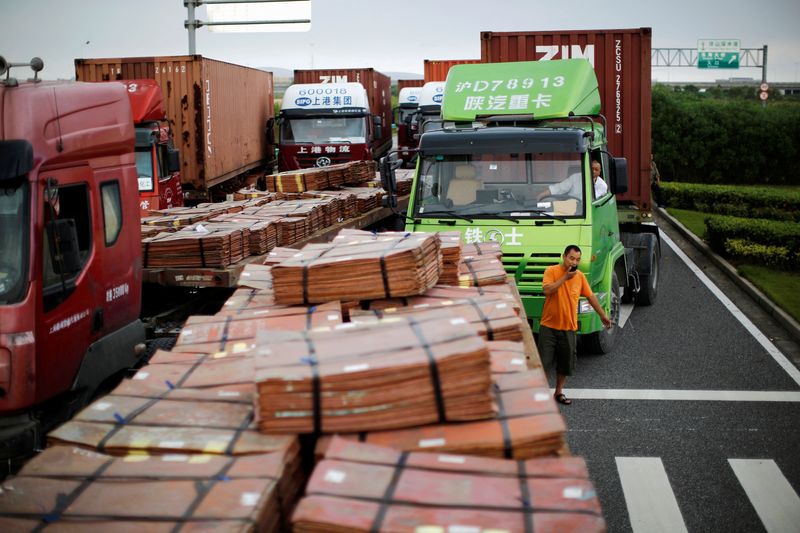(Corrects spelling to “Uyghur” and not “Uygur”, paragraphs 2, 14)
(Reuters) – The Russian Copper Company (RCC) and Chinese firms have avoided taxes and circumvented the impact of Western sanctions by trading new wire rod disguised as scrap, three sources familiar with the matter told Reuters.
Copper wire rod was shredded in the remote Uighur region of Xinjiang by a middleman to make it difficult to distinguish from scrap, the sources said, allowing both exporters and importers to profit from differences in tariffs applied to scrap and new metals , the sources said.
In December, the Russian export duty on copper wire rod was 7%, lower than the 10% levy on scrap. Imports of copper wire rod into China are taxed at 4% and there are no tariffs on Russian scrap imports.
Sales of new metal disguised as scrap, which began in December, are reflected in a discrepancy between Chinese and Russian data.
Chinese customs data shows that China has bought significantly more copper scrap from Russia since December, while Russian data obtained by Reuters from a trade data provider shows that the amount of scrap exported to the country’s main trading partner it was negligible.
In response to a Reuters inquiry into the discrepancy, Russian customs said: “The Federal Customs Service temporarily does not provide data on foreign trade.” It stopped publishing trade data in April 2022, shortly after Russia invaded Ukraine. Since then the market has relied on commercial suppliers.
Asked about trading copper bars with Chinese companies, the RCC, which is under Western sanctions, said it supplies products only to Russian companies. He did not comment further.
Chinese customs in Xinjiang, which borders Russia, did not respond to an emailed inquiry and a phone call.
China has become a major destination for Russian companies seeking to export their raw materials after the United States imposed sanctions on Russia over its invasion of Ukraine in February 2022.
The United States and the European Union have imposed sanctions on Chinese companies for supporting Russia’s war effort in Ukraine.
DISGUISE
Shredding freshly produced copper wire rod is an effective way to disguise new material that looks very different from scrap.
The new long, thin rods of high-purity copper, used primarily to make power cables, are generally rolled for ease of transportation.
Copper scrap, on the other hand, is a mix of already used wire, tubes and pipes. They are cut into pieces of the grain size or rolled and pressed, like packs of noodles, for transport.
The destruction had escaped notice as China restricted access to the Xinjiang region in response to international condemnation of the Uyghur crackdown, the sources said.
Aside from the financial incentive of tax avoidance, shredded metal is harder to identify and trace, making it easier to sell to Chinese manufacturers.
In theory, there are no legal obstacles preventing China from buying metal from Russian firms under Western sanctions, but producers may still be wary of losing export business to buyers seeking to avoid providing funds to Russia.
Fines can also mean difficulty processing payments and borrowing money. The sources say some Chinese companies have created new teams to handle Russia-related businesses.
‘DE FACTO COPPER ROD’
Last December, Chinese companies made a total of five purchases of products labeled “copper rod” from the RCC plant in the Urals region, according to a trade data provider. According to the trade data provider, purchases made by a UAE-based entity called Modern Commodity Trading DMCC generated revenues of around $65 million.
The UAE-based company could not be reached for comment.
Russia has never been a big seller of copper scrap to China.
However, since December last year, China’s imports of copper scrap from Russia have increased significantly, customs data showed.
The majority, 97% or 6,434 tonnes, arrived through the Alashankou border in Xinjiang in December.
Russian data showed a discrepancy, indicating that the country sold only 73 tons of copper scrap to China in the same month.
In 2021 and 2022, an average of 95.3 and 125 tons of Russian copper scrap were sold to China each month.
Volumes have increased significantly in recent months, with monthly imports reaching 11,599 tonnes by February 2024.
Customs data on Chinese copper wire rod imports is not publicly available.
“This scrap from Russia is in fact copper rods, but not declared as rods. I cannot reveal further details,” said a Chinese manufacturing source who asked to remain anonymous. The source added that the material could be directly consumed by copper producers in Jiangsu and Zhejiang provinces.
While Russian data showed minimal scrap exports, there was a sudden increase in wire rod exports in December.
According to the data, “Kyshtym Copper Electrolyte Plant JSC”, a plant operated by RCC, delivered 8,041 tonnes of copper wire rod to China via Alashankou in Xinjiang in December compared to just 1,618 tonnes in November.

“To date, the Kyshtym copper electrolyte plant sells its products only to domestic companies,” the Kyshtym plant said in response to questions from Reuters about its sales in China.
“We have not monitored the further fate of the products, so I have nothing to add to what has already been said.”